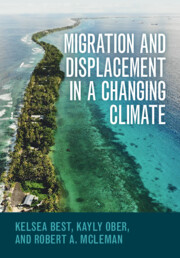Book contents
- Migration and Displacement in a Changing Climate
- Reviews
- Migration and Displacement in a Changing Climate
- Copyright page
- Contents
- Preface
- Acknowledgments
- 1 People on the Move in a Changing Climate
- 2 Migration and Displacement Associated with Extreme Weather Events
- 3 Migration and Displacement Associated with Aridity, Drought, Heat, and Wildfires
- 4 Migration and Displacement Risks Associated with Mean Sea Level Rise
- 5 Data and Methods for Modeling Climate-Related Migration
- 6 Policy Considerations
- 7 Emerging Issues and Future Directions
- Glossary
- References
- Index
3 - Migration and Displacement Associated with Aridity, Drought, Heat, and Wildfires
Published online by Cambridge University Press: 10 April 2025
- Migration and Displacement in a Changing Climate
- Reviews
- Migration and Displacement in a Changing Climate
- Copyright page
- Contents
- Preface
- Acknowledgments
- 1 People on the Move in a Changing Climate
- 2 Migration and Displacement Associated with Extreme Weather Events
- 3 Migration and Displacement Associated with Aridity, Drought, Heat, and Wildfires
- 4 Migration and Displacement Risks Associated with Mean Sea Level Rise
- 5 Data and Methods for Modeling Climate-Related Migration
- 6 Policy Considerations
- 7 Emerging Issues and Future Directions
- Glossary
- References
- Index
Summary
The present chapter focuses on migration and displacement associated with events that are directly linked to hotter air temperatures and/or an associated lack of moisture experienced at local and regional scales: droughts, increased aridity, desertification, heat, and wildfires. With the exception of wildfires – which share many characteristics comparable to rapid-onset extreme weather events – the hazards assessed in the present chapter are gradual in their onset and impacts. Their impacts accumulate with each passing week, month, and/or year, steadily eroding the water, food and/or livelihood security of households and communities. The slow rate of onset allows exposed populations an opportunity to adjust and adapt through means that do not require changes to existing mobility practices and patterns, sometimes referred to as in situ adaptation responses. It is only after hot and/or dry conditions persist beyond a particular threshold of duration and/or severity that in situ adaptations no longer prove to be sufficient and changes in migration decision-making and outcomes emerge.
- Type
- Chapter
- Information
- Migration and Displacement in a Changing Climate , pp. 95 - 130Publisher: Cambridge University PressPrint publication year: 2025

